Hands-on with Total War: Warhammer's Vampires
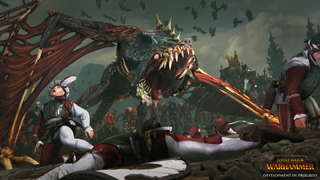
The secret to a creating an effective bad guy is realistic motivation. Mannfred Von Carstein, head of the Vampire Counts faction in Total War: Warhammer, believes he has a legitimate claim to the Empire. You’re not just spreading corruption and undeath across the Old World when you play as Mannfred—you’re dutifully reclaiming what’s yours. Only a fool lets minor issues such as vampirism stand in the way of good government.
This sense of righteous slaughter tempers everything I do in the preview build of Total War: Warhammer. I begin in Sylvania, a former province of the Empire, nestled at the feet of the World’s Edge mountains. It’s a richly twisted landscape of cruel trees and cursed soil. Obdurate dwarfs frown down at me from mountain fortresses, and The Empire lies gleaming to the west. The starkly defined cultures make me feel threatened. I want to expand, gain strength and protect my borders. More than that, I want to conquer. It feels great to be this bad.
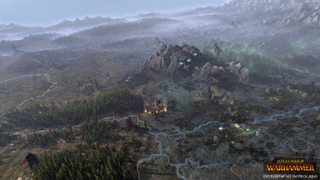
This is a Total War game, so I begin in a position of relative weakness. I have a moderate army with some unique units, led by a powerful lord character. My first goal is to tighten my grip on Sylvania by wresting back power from my mewling necromancer neighbours. There’s something deeply satisfying about bringing lesser lords to heel—ideally while drinking something red from a goblet shaped like the Devil’s kneecap—and it’s a great way of introducing how the Vampire Counts fight.
They’re different from every other Total War faction. Like the tabletop game, your core units are literally rotten. Zombies shuffle forward with the urgency of a pensioner at the self-service checkouts, and they’re equally ineffectual in a fight. Skeletons are more capable, but will still get smashed by most infantry. Vampire Counts also have no ranged weaponry whatsoever. This is a tactical kick to the gonads for me, because I’m used to playing as England in Medieval 2. There’s no Sylvanian word for ‘longbow’.
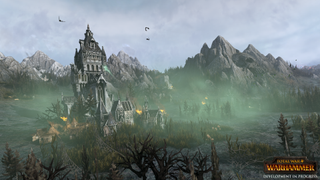
There is some good news, though—there’s also no word for ‘flee’. Being dead, your units will never run from a fight. What could they possibly be afraid of? Instead, they crumble in situations where normal units would rout—and if your lord falls in battle, it’s all over—but losses don’t affect their morale. Vampire Counts also have access to the best flying units in the game. You can harass enemy artillery with giant bats, or tie-up elite infantry with the terrifying Vargheists (‘the darkness in a Vampire's soul made manifest’, or ‘big bad bat-men’). This completely changes the dynamic of the army, and I love it. A groaning tattoo of flyblown infantry urges itself to battle under a sky blackened by tattered wings. Because zombies are completely expendable, you can screen more precious units from projectile fire. It’s like using peasants in Medieval 2, but without the feudal disregard for human life. Maybe it’s The Empire that are actually evil, and not the vampires, yeah? Think on that, humans.
A groaning tattoo of flyblown infantry urges itself to battle under a sky blackened by tattered wings.
You can’t have Vampire Counts without necromancy, and this is another game-changer. It doesn’t matter if your troops are dying, because you can just raise more. All existing units can be bolstered with spells, and you can unlock the ability to raise new units from scratch. What’s striking is how natural it feels. You’ll be thinking like a Warhammer player, but implementing strategy with the simple immediacy of Total War.
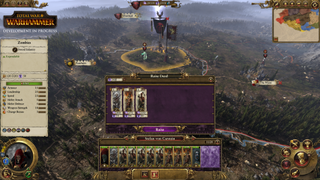
With standard necromancers, it feels right to have them hang back and bolster units from a position of safety, but you’ll want to get your Vampire Lords stuck in. As in the tabletop game, they’re some of the toughest lords around (they have, after all, had thousands of years to practice fighting). Unfortunately, controlling lords can feel fiddly, especially if you’re used to directing the massive units of a normal Total War game. (Micromanagement is for humans, not the ageless, unspeakable and all-powerful.) It’s empowering when you get the hang of it, though. Raising new units behind enemy lines feels like the first thing they teach you in necromancer school—shortly before Cackling 101—and it works exactly how you’d expect. Lesser enemies panic and rout, and even the most capable foe can be outmanoeuvred. Your opponent must be as prepared for the dead beneath them as the enemy in front of them.
The biggest gaming news, reviews and hardware deals
Keep up to date with the most important stories and the best deals, as picked by the PC Gamer team.
The deft incorporation of the Warhammer world is even clearer on the campaign map. To advance, you spread vampiric corruption by building certain structures in your settlements. The landscape changes as you progress, and your gnarled campaign advisor directs you on the correct course of action. It’s satisfyingly depraved, and it gives you a real sense of control over the world. Every battle is a chance to build character and establish your place in an immersive, emergent fantasy setting. I rename some units, which makes me even more attached to them. I’m genuinely sad when Nigel, my favourite Varghulf, dies (and not only because he’s great at killing rival necromancers. Sleep peacefully, my leathery prince).
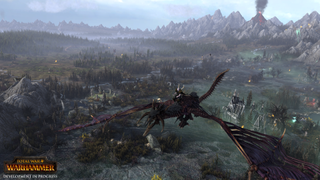
You get the same sense of ownership from character progression. Lords level up as you fight battles, and you can decide how they develop. Popping points into branching skill trees reminds me of the intricate character creation process in Warhammer, but instead of balancing the points value of each upgrade, your lord gradually gets more capable. Eventually, you’ll receive missions to unlock legendary items such as the Sword of Unholy Power. It’s a great way of adding narrative to each step of your journey. Instead of just picking from a list, you create a story about how you met your zombie dragon.
This, then, is the true joy of the game. You’re not just directing skirmishes in a tale written by someone else. You’re writing your own Warhammer fluff as you go. Stretch this prospect across four different races (five if you include Chaos—pre-orders for the pre-order god!), and Total War: Warhammer feels more generous than the limited roster initially suggests. You can keep your fragile humans, rowdy greenskins and dreary dwarfs, though—my Old World will be one of blood, bats and monsters called Nigel.

If you love big trucks, establishing trade routes, and the phrase 'post-apocalyptic survival business simulator' then I've got just the strategy RPG for you

Blizzard veteran David Kim's strategy comeback with Battle Aces is 'very personal:' 'I just can't accept... the end-all peak of RTS is StarCraft 2 and nothing can ever be better'
Most Popular

